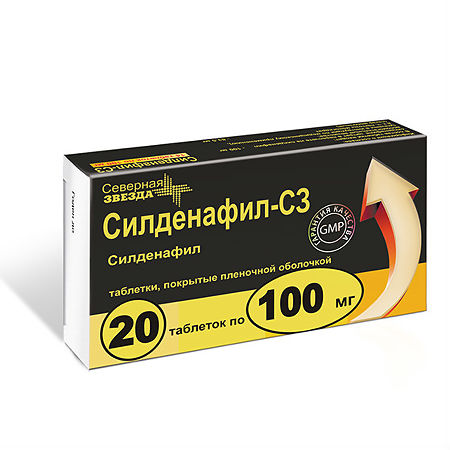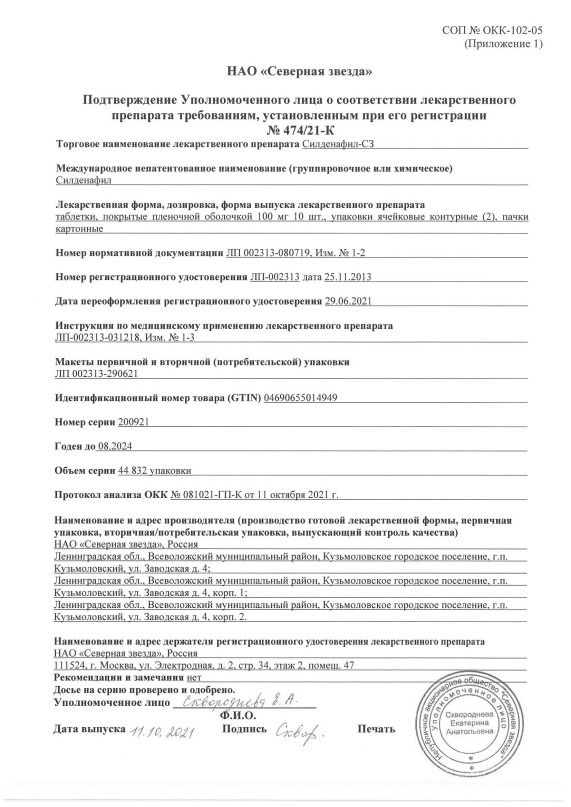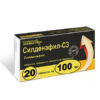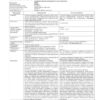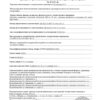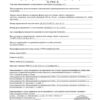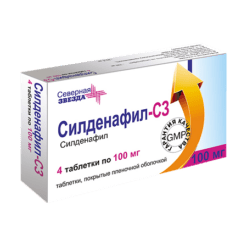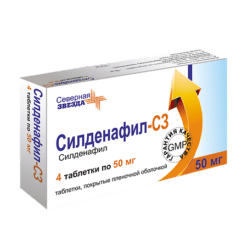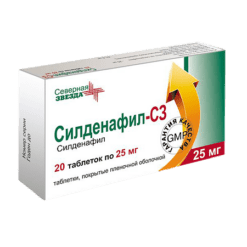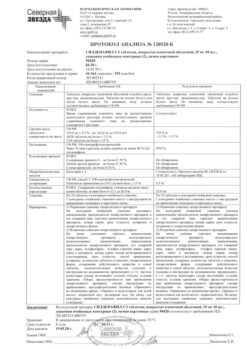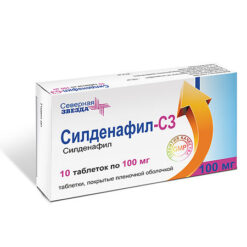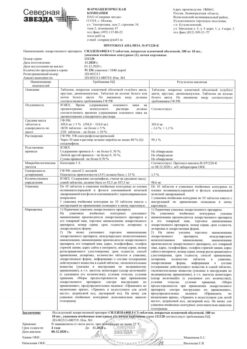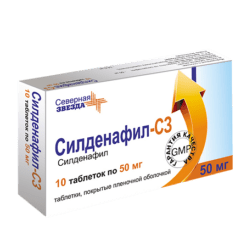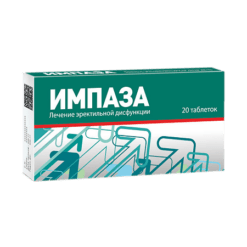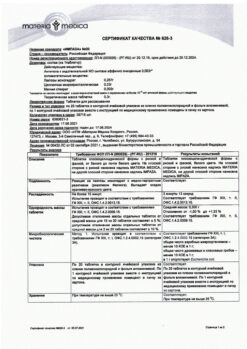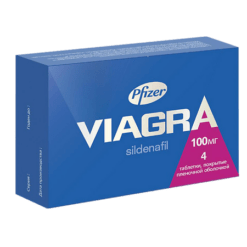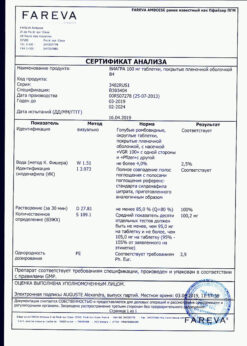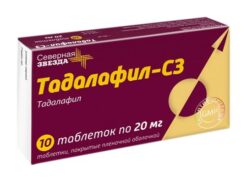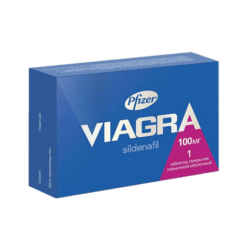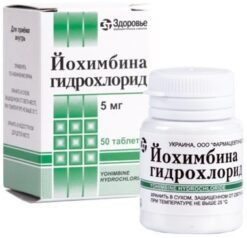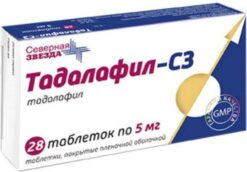No products in the cart.
Sildenafil-SZ, 100 mg 20 pcs
€16.73 €15.31
Description
Sildenafil is a drug that has a positive effect on blood circulation in the pelvic area by dilating the blood vessels.
Effectively used to restore erectile function in men, as well as to normalize blood flow in the penis.
Sildenafil maintains the hardness of the organ sufficient to perform a complete act, also prolonging it.
It does not work on its own, but only in the presence of arousal stimulation.
Its use leads to a decrease in pressure in the lungs, reducing shortness of breath.
It is used in the existing erectile dysfunction, complete sexual impotence, for the elimination of pathological conditions of the pulmonary artery.
Indications
Indications
Remedy:
psychogenic erectile dysfunction;
mixed erectile dysfunction;
organic erectile dysfunction.
Pharmacological effect
Pharmacological effect
Sildenafil is a drug that has a positive effect on blood circulation in the pelvic area by dilating blood vessels.
It is effectively used to restore erectile function in men, as well as normalize blood flow in the penis.
Sildenafil maintains the hardness of the organ sufficient to perform a full-fledged act, also prolonging it.
It does not act independently, but only in the presence of exciting stimulation.
Its use leads to a decrease in pressure in the lungs and a decrease in shortness of breath.
It is used for existing erectile dysfunctions, complete sexual impotence, and to eliminate pathological conditions of the pulmonary artery.
Special instructions
Special instructions
To diagnose erectile dysfunction, determine its possible causes and select adequate treatment, it is necessary to obtain a complete medical history and conduct a thorough physical examination. Treatments for erectile dysfunction should be used with caution in patients with anatomical deformation of the penis (angulation, cavernous fibrosis, Peyronie’s disease), or in patients with risk factors for the development of priapism (sickle cell anemia, multiple myeloma, leukemia).
Medicines intended to treat erectile dysfunction should not be prescribed to men for whom sexual activity is undesirable.
Sexual activity poses a certain risk in the presence of heart disease, so before starting any therapy for erectile dysfunction, the doctor should refer the patient for an examination of the condition of the cardiovascular system. Sexual activity is undesirable in patients with heart failure, unstable angina, myocardial infarction or stroke in the last 6 months, life-threatening arrhythmias, arterial hypertension (BP > 170/100 mm Hg) or hypotension (BP < 90/50 mm Hg). Clinical studies have shown no difference in the incidence of myocardial infarction (1.1 per 100 people per year) or the incidence of death from cardiovascular diseases (0.3 per 100 people per year) in patients receiving Sildenafil compared with patients receiving placebo.
Cardiovascular complications
During post-marketing use of sildenafil for the treatment of erectile dysfunction, adverse events such as serious cardiovascular events (including myocardial infarction, unstable angina, sudden cardiac death, ventricular arrhythmia, hemorrhagic stroke, transient ischemic attack, hypertension and hypotension) were reported, which were temporarily associated with the use of sildenafil. Most of these patients, but not all of them, had risk factors for cardiovascular complications. Many of these adverse events occurred shortly after sexual activity, and some of them occurred after taking sildenafil without subsequent sexual activity. It is not possible to establish a direct connection between the observed adverse events and these or other factors.
Hypotension
Sildenafil has a systemic vasodilating effect, leading to a transient decrease in LD, which is not a clinically significant phenomenon and does not lead to any consequences in most patients. However, before prescribing Sildenafil, the physician should carefully assess the risk of possible undesirable manifestations of the vasodilating effect in patients with relevant diseases, especially against the background of sexual activity. Increased susceptibility to vasodilators is observed in patients with obstruction of the left ventricular outflow tract (aortic stenosis, hypertrophic obstructive cardiomyopathy), as well as with the rare syndrome of multiple system atrophy, manifested by severe dysregulation of blood pressure from the autonomic nervous system.
Since the combined use of sildenafil and α-blockers may lead to symptomatic hypotension in some sensitive patients, Sildenafil should be administered with caution to patients taking α-blockers. To minimize the risk of developing postural hypotension in patients taking alpha-blockers, Sildenafil should be started only after hemodynamic parameters have stabilized in these patients. The advisability of reducing the initial dose of Sildenafil should also be considered. The physician should inform patients about what actions to take if symptoms of postural hypotension occur.
Visual impairment
Rare cases of anterior non-arteritic ischemic optic neuropathy as a cause of deterioration or loss of vision have been reported with the use of all PDE5 inhibitors, including sildenafil. Most of these patients had risk factors such as optic disc excavation, age over 50 years, diabetes mellitus, hypertension, coronary artery disease, hyperlipidemia, and smoking. A cause-and-effect relationship between the use of PDE5 inhibitors and the development of anterior non-arteritic ischemic optic neuropathy has not been identified. The physician should inform the patient about the increased risk of developing anterior non-arteritic ischemic optic neuropathy if this condition has already been noted. In case of sudden loss of vision, patients should receive the necessary medical attention immediately. A small number of patients with hereditary retinitis pigmentosa have genetically determined dysfunction of retinal phosphodiesterases. There is no information on the safety of using Sildenafil in patients with retinitis pigmentosa, so sildenafil should be used with caution.
Hearing impairment
Some post-marketing and clinical studies have reported cases of sudden deterioration or loss of hearing associated with the use of all PDE5 inhibitors, including sildenafil. Most of these patients had risk factors for sudden deterioration or loss of hearing. A cause-and-effect relationship between the use of PDE5 inhibitors and sudden hearing loss or deterioration has not been established. If there is a sudden deterioration in hearing or hearing loss while taking sildenafil, you should consult your doctor immediately.
Bleeding
Sildenafil enhances the antiplatelet effect of sodium nitroprusside, a nitric oxide donor, on human platelets in vitro. There are no data on the safety of sildenafil in patients with a tendency to bleeding or exacerbation of gastric and duodenal ulcers, so Sildenafil should be used with caution in these patients. The incidence of epistaxis in patients with PH associated with diffuse connective tissue diseases was higher (sildenafil 12.9%, placebo 0%) than in patients with primary pulmonary hypertension (sildenafil 3.0%, placebo 2.4%). Patients receiving sildenafil in combination with a vitamin K antagonist had a higher incidence of epistaxis (8.8%) than patients not taking a vitamin K antagonist (1.7%).
Use in conjunction with other means of treating erectile dysfunction.
The safety and effectiveness of Sildenafil in combination with other drugs for the treatment of erectile dysfunction have not been studied, so the use of such combinations is not recommended.
Impact on the ability to drive vehicles and operate machinery
While taking sildenafil, no negative effects on the ability to drive a car or use other technical equipment were observed.
However, since taking sildenafil may reduce blood pressure, develop chromatopsia, blurred vision, etc. side effects, you should carefully consider the individual effect of the drug in these situations, especially at the beginning of treatment and when changing the dosage regimen.
Active ingredient
Active ingredient
Sildenafil
Composition
Composition
Pills
Active ingredient:
sildenafil (in the form of citrate) 100 mg
Excipients:
microcrystalline cellulose 83.5 mg,
lactose monohydrate 83.5 mg,
croscarmellose sodium 15 mg,
povidone 15 mg,
magnesium stearate 3 mg.
Film shell composition:
Opadry II (polyvinyl alcohol, partially hydrolyzed 3.6 mg, titanium dioxide 2.061 mg, macrogol 1.818 mg, talc 1.332 mg, aluminum varnish based on brilliant blue 0.1728 mg, iron oxide (II) yellow 0.0153 mg, iron oxide (II) black 0.0009 mg).
Contraindications
Contraindications
Presence of Peyronie’s disease;
Presence of penile anuglation;
The presence of cavernous fibrosis of the penis;
Increased tendency to bleeding;
Functional failure of the liver;
Presence of liver cirrhosis;
Various diseases that cause priapism;
Presence of sickle cell anemia;
Various heart diseases;
Individual intolerance to Sildenafil or its components;
Presence of arrhythmia;
Ulcerative lesions of the stomach in the acute phase;
Ulcerative lesions of the duodenum in the acute phase;
Presence of leukemia;
The presence of various anatomical pathologies of the penis;
Presence of multiple myeloma;
Reduced level of total blood pressure in severe form;
Hypersensitivity to yoghurt or its components;
Elevated levels of total blood pressure in severe form;
Use of Sildenafil in pediatric patients;
Simultaneous use of the drug with drugs from the group of nitric oxide donors;
Simultaneous use of Sildenafil with drugs from the nitrate group;
Use in female patients.
Side Effects
Side Effects
General condition disorders: facial swelling, photosensitivity reactions, shock, asthenia, pain, chills, abdominal pain, chest pain.
Allergic reactions: hypersensitivity reactions (including skin rash), Stevens-Johnson syndrome, toxic epidermal necrolysis (Lyell’s syndrome).
Disorders of the central and peripheral nervous system: drowsiness, insomnia, hypoesthesia, paresthesia, ataxia, neuralgia, neuropathy, tremor, depression, unusual dreams, decreased reflexes, stroke, transient ischemic attack, convulsions, incl. recurrent.
Cardiovascular system disorders: tachycardia, increased or decreased blood pressure, myocardial infarction, atrial fibrillation, ventricular arrhythmia, unstable angina, AV block, cerebral thrombosis, heart failure, ECG abnormalities, cardiomyopathy, sudden death, syncope.
Respiratory disorders: nosebleeds, asthma, shortness of breath, laryngitis, pharyngitis, sinusitis, bronchitis, increased sputum production, increased cough.
Gastrointestinal disorders: vomiting, nausea, dry oral mucosa, glossitis, colitis, dysphagia, gastritis, gastroenteritis, esophagitis, stomatitis, rectal bleeding, gingivitis.
Visual disorders: eye pain, eye redness/scleral injections, conjunctival damage, lacrimation disorders, anterior ischemic optic neuropathy, retinal vascular occlusion, visual field defects, mydriasis, cataracts, eye pain.
Hearing disorders: vertigo, tinnitus, ear pain, deafness.
Blood and lymphatic system disorders: anemia, leukopenia.
Metabolic and nutritional disorders: thirst, gout, unstable diabetes, hyperglycemia, peripheral edema, hyperuricemia, hypoglycemic reaction, hypernatremia.
Musculoskeletal disorders: arthritis, arthrosis, myalgia, tendon rupture, tendovaginitis, bone pain, myasthenia gravis, synovitis.
Skin and subcutaneous tissue disorders: urticaria, herpes simplex, itching, sweating, skin ulcers, contact dermatitis, exfoliative dermatitis.
Disorders of the genitourinary system: cystitis, nocturia, frequent urination, gynecomastia, urinary incontinence, ejaculation disorders, genital swelling, anorgasmia.
Reproductive system disorders: prolonged erection and/or priapism.
Interaction
Interaction
The influence of other drugs on the pharmacokinetics of sildenafil
The metabolism of sildenafil occurs mainly under the influence of the cytochrome isoenzymes CYP3A4 (the main pathway) and CYP2C9, therefore inhibitors of these isoenzymes can reduce the clearance of sildenafil, and inducers, accordingly, increase the clearance of sildenafil.
A decrease in the clearance of sildenafil was noted with simultaneous use of inhibitors of the cytochrome CYP3A4 isoenzyme (ketoconazole, erythromycin, cimetidine). Cimetidine (800 mg), a nonspecific inhibitor of the cytochrome CYP3A4 isoenzyme, when taken together with sildenafil (50 mg), causes an increase in plasma sildenafil concentrations by 56%. A single dose of 100 mg of sildenafil together with erythromycin (500 mg/day 2 times a day for 5 days), a specific inhibitor of the cytochrome CYP3A4 isoenzyme, while achieving a constant concentration of erythromycin in the blood, leads to an increase in the AUC of sildenafil by 182%.
When co-administered with sildenafil (100 mg once) and saquinavir (1200 mg/day 3 times a day), an inhibitor of HIV protease and the cytochrome CYP3A4 isoenzyme, while achieving a constant concentration of saquinavir in the blood, the Cmax of sildenafil increased by 140%, and the AUC increased by 210%. Sildenafil has no effect on the pharmacokinetics of saquinavir.
Stronger inhibitors of the cytochrome CYP3A4 isoenzyme, such as ketoconazole and itraconazole, may cause more severe changes in the pharmacokinetics of sildenafil.
The simultaneous use of sildenafil (100 mg once) and ritonavir (500 mg 2 times a day), an HIV protease inhibitor and a strong cytochrome P450 inhibitor, while achieving a constant concentration of ritonavir in the blood leads to an increase in sildenafil Cmax by 300% (4 times), and AUC by 1000% (11 times). After 24 hours, the concentration of sildenafil in the blood plasma is about 200 ng/ml (after a single dose of sildenafil alone – 5 ng/ml), which is consistent with information about the pronounced effect of ritonavir on the pharmacokinetics of various cytochrome P450 substrates. Sildenafil has no effect on the pharmacokinetics of ritonavir. The combined use of sildenafil with ritonavir is not recommended. If sildenafil is taken in recommended doses by patients simultaneously receiving strong inhibitors of the cytochrome CYP3A4 isoenzyme, then the Cmax of free sildenafil does not exceed 200 nM, and the drug is well tolerated.
A single dose of an antacid (magnesium hydroxide/aluminum hydroxide) does not affect the bioavailability of sildenafil.
Inhibitors of the cytochrome CYP2C9 isoenzyme (tolbutamide, warfarin), the cytochrome CYP2D6 isoenzyme (selective serotonin reuptake inhibitors, tricyclic antidepressants), thiazide and thiazide-like diuretics, ACE inhibitors and calcium antagonists do not affect the pharmacokinetics of sildenafil.
Azithromycin (500 mg/day for 3 days) has no effect on the AUC, Cmax Tmax, elimination rate constant and T1/2 of sildenafil or its main circulating metabolite.
Effect of sildenafil on other drugs
Sildenafil is a weak inhibitor of cytochrome P450 isoenzymes -1A2, 2C9, 2C19, 2D6, 2E1 and 3A4 (IC50>150 µmol). When sildenafil is taken at recommended doses, its Cmax is approximately 1 µmol, so it is unlikely that sildenafil could affect the clearance of substrates of these isoenzymes.
Sildenafil enhances the hypotensive effect of nitrates both with long-term use of the latter and when they are prescribed for acute indications. In this regard, the use of sildenafil in combination with nitrates or nitric oxide donors is contraindicated.
When taking the α-blocker doxazosin (4 mg and 8 mg) and sildenafil (25 mg, 50 mg and 100 mg) simultaneously in patients with benign prostatic hyperplasia with stable hemodynamics, the average additional decrease in systolic/diastolic blood pressure in the supine position was 7/7 mm Hg. art., 9/5 mm Hg. and 8/4 mm Hg, respectively, and in a standing position – 6/6 mm Hg, 11/4 mm Hg. and 4/5 mmHg, respectively. Rare cases of symptomatic postural hypotension, manifested in the form of dizziness (without fainting), have been reported in such patients. In selected sensitive patients receiving α-blockers, concomitant use of sildenafil may lead to symptomatic hypotension.
There were no signs of significant interaction with tolbutamide (250 mg) or warfaria (40 mg), which are metabolized by the cytochrome CYP2C9 isoenzyme.
Sildenafil (100 mg) does not affect the pharmacokinetics of HIV protease inhibitors, saquinavir and ritonavir, which are substrates of the cytochrome CYP3A4 isoenzyme, at their constant blood levels. Sildenafil (50 mg) does not cause an additional increase in bleeding time when taking acetylsalicylic acid (150 mg). Sildenafil (50 mg) does not enhance the hypotensive effect of alcohol in healthy volunteers with a maximum blood alcohol concentration of 0.08% (80 mg/dL) on average.
In patients with arterial hypertension, no signs of interaction between sildenafil (100 mg) and amlodipine were detected. The average additional decrease in blood pressure in the supine position is 8 mm Hg. (systolic) and 7 mm Hg. (diastolic).
The use of sildenafil in combination with antihypertensive drugs does not lead to additional side effects.
Overdose
Overdose
With a single dose of Sildenafil in doses up to 800 mg, adverse events were comparable to those when taking the drug in lower doses, but were more common.
Treatment is symptomatic. Hemodialysis does not accelerate the clearance of sildenafil, since the latter actively binds to plasma proteins and is not excreted by the kidneys.
Storage conditions
Storage conditions
In a place protected from light, at a temperature not exceeding 25 °C.
Shelf life
Shelf life
2 years
Manufacturer
Manufacturer
North Star NAO, Russia
Additional information
| Shelf life | 2 years |
|---|---|
| Conditions of storage | In a light-protected place at a temperature not exceeding 25 °C. |
| Manufacturer | North Star NAO, Russia |
| Medication form | pills |
| Brand | North Star NAO |
Other forms…
Related products
Buy Sildenafil-SZ, 100 mg 20 pcs with delivery to USA, UK, Europe and over 120 other countries.

